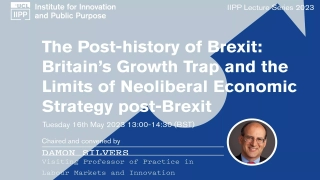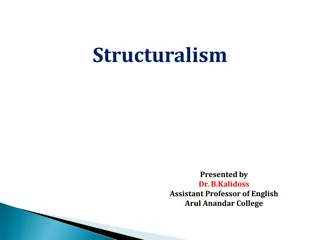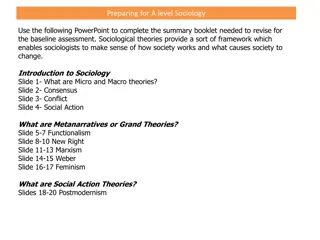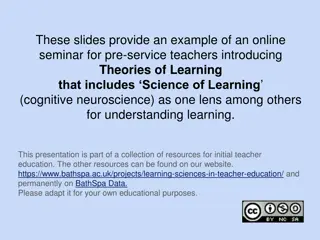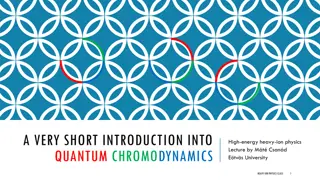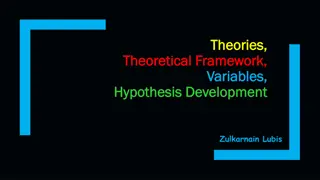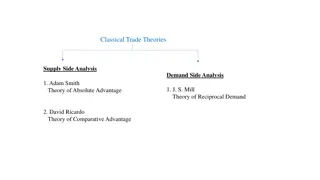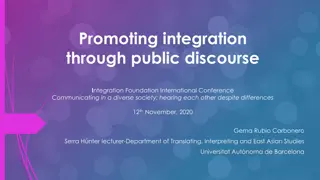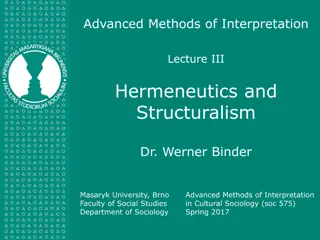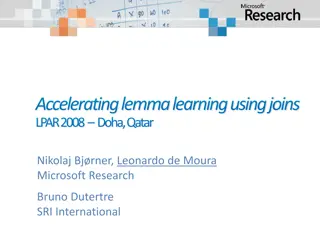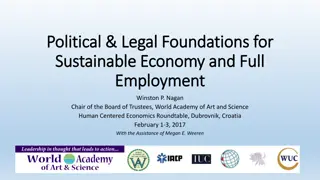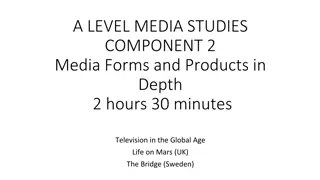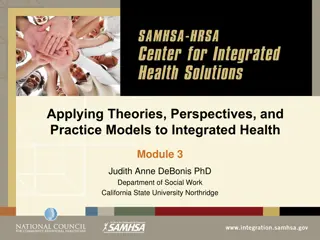Theories of International Integration: From Neoliberalism to Structuralism
The concept of international integration has evolved over time, with classic theories like federalism and functionalism giving way to newer ideas like neoliberalism and structuralism. Neoliberalism emphasizes economic liberalization for improved competitiveness and living standards, while structuralism critiques the potential social inequalities stemming from lack of control within integrated economies. Understanding these theories is crucial for navigating the complexities of global cooperation and economic relationships.
Download Presentation

Please find below an Image/Link to download the presentation.
The content on the website is provided AS IS for your information and personal use only. It may not be sold, licensed, or shared on other websites without obtaining consent from the author.If you encounter any issues during the download, it is possible that the publisher has removed the file from their server.
You are allowed to download the files provided on this website for personal or commercial use, subject to the condition that they are used lawfully. All files are the property of their respective owners.
The content on the website is provided AS IS for your information and personal use only. It may not be sold, licensed, or shared on other websites without obtaining consent from the author.
E N D
Presentation Transcript
THEORIZING INTERNATIONAL INTEGRATION
THEORIZING INTERNATIONAL INTEGRATION An idea of international integration: 1) Emerged in the 1930s; 2) Was based on the views of the European intellectuals and politicians who survived two world wars; 3) Identified and explained the principles of functioning of the IOs known at that time the League of Nations, the UN, etc.; 4) Examined the idea of preserving peace through voluntary association of countries and peoples.
THEORIES OF INTERNATIONAL INTEGRATION: Classic ( high ): federalism, functionalism, intergovernmentalism; Neo-institutional ( middle ): historical neo-institutionalism, neo- institutionalism of rational choice, sociological neo-institutionalism; New ( low ): theories of political networks, multi-level governance, etc.
NEOLIBERALISM (MAURICE ALLAIS, WILHELM R PKE) Integration is the establishment of a common economic area of two or more countries with liberating foreign trade and finance from state control. The ways to integration: 1) Merger of the markets; 2) Increasing specialization of production; 3) Growth of IDL.
NEOLIBERALISM These would result in: 1) Raising the competitiveness of the integrated economies; 2) Stimulating the efficiency of production; 3) Improving the living standards of the population.
STRUCTURALISM (GUNNAR MYRDAL): Criticized the neoliberal idea of foreign trade liberalization within an IO as the lack of control may cause: 1) Disparities in the distribution and development of production; 2) Deepening social inequality.
STRUCTURALISM: 1) Integration is a part of restructuring of the integrated nations economies; 2) Large companies and entire industries are the driving forces of integration; 3) Integration should lead to the creation of new economic space with an improved model of management.
CORPORATIONALISM (SYDNEY ROLF, EUGENE ROSTOW): 1) International corporations (MNCs) are the locomotives of integration; 2) MNCs stimulate balanced growth and rationalization of the world economy.
NEO-KEYNESIANISM (RICHARD COOPER) Close coordination in domestic and foreign affairs of the IOs participants is a key to successful integration with an optimum combination of the two possible ways of international integration: 1) Maximum preservation of independence of its participants; 2) Abandoning national sovereignty and coordination of economic policies.
DIRIGISME (A KIND OF KEYNESIANISM, JAN TINBERGEN): 1) Denies the crucial role of market in integration; 2) Believes the formation and functioning of IOs are possible through: A) Common economic and monetary policy; B) The harmonization of social legislation.
FEDERALISM: 1) The earliest ideological trend in studying international integration (emerged in the 1930s); 2) It is critical towards a nation state as an institution blamed for two world wars which brought so much trouble to the peoples of Europe and caused the crisis of European civilization.
FEDERALISM Amitai Etzioni, Altiero Spinelli, Carl Friedrich, Daniel Eleyzer: 1) Considered federative relations as the most preferable; 2) Understood federalism as repudiation of centralization based on general agreement and vesting multiple centers of power with governmental authority insuring it by the adoption of a constitutional act.
FEDERALISM A nation state is unable to do the following: 1) Remove violence from political life; 2) Suppress radical nationalist and religious movements; 3) Prevent the emergence of authoritarian and totalitarian political regimes; 4) Renounce war as a way to solve international disputes with the result that a nation state loses its credibility.
FEDERALISM: 1) Gives priority to the political rather than the economic side of integration; 2) Its main advantage is seen in the possibility of an optimum balance of the elements of unity and specific features of IOs participants.
FEDERALISM: 1) Focus on vertical and horizontal aspects of political and economic power; 2) The horizontal aspect is a guarantee of democratic organization of political life; 3) The vertical aspect means the concentration of power in the hands of people, with a rigid adherence to the principle of the separation of powers.
FEDERALISM: 1) Implies a high degree of power centralization as a precondition for successful integration; 2) An active participation of civil society in the integration projects is another condition for success and sustainability of IOs.
FEDERALISM: 1) Assigns an important role to the establishment and functioning of institutions; 2) A guarantee of successful integration is seen in giving extensive powers and authority to supranational institutions and their priority over the national ones.
FEDERALISM: 1) Replacement of a nation state by a supranational union of federal nature; 2) A nation state as a way of social organization is not fully given up; 3) The outcome of integration must be a supranational mega-state.
FEDERALISM Its critics pay attention to the following: 1) Focus on the political aspects of integration without due consideration of its economic side; 2) The means of control over state power is essentially the state itself; 3) Supranational federation gives way to a new bureaucracy and its conflict with civil society; 4) The system of checks and balances in a nation state is more effective than in a supranational federation; 5) Supranational federation may engage in wars with other supranational unions.
FUNCTIONALISM: 1) Emerged in the 1930s; 2) Is based on the critique of a nation state as an institution; 3) Involves replacing the existing system of international relations with a system of supranational institutions whose form should be determined by the functions they perform.
FUNCTIONALISM: 1) Had first been formulated by D. Mitrany; 2) Is aimed at eliminating war as a method of solving international disputes. D. Mitrany: 1) Integration makes sense only if there are common problems whose solution is beyond the capacity of individual states; 2) The interest in cooperation to resolve them (a natural selection of interests) really exists.
FUNCTIONALISM Levels of integration: 1) Political (cooperation between states); 2) Technocratic (social and economic problems).
FUNCTIONALISM: 1) An aspiration to power expansion at the expense of other states generates conflicts at the political level and makes cooperation impossible; 2) The firmest foundation of integration is technocracy for which such contradictions and conflicts are not so typical; 3) Technocratic dimension must be removed from the jurisdiction of a nation state.
FUNCTIONALISM: 1) Cooperation in the technocratic area should bolster cooperation between specialized groups and individuals involved in it, resulting in the new relationships within these groups; 2) Mitrany designated this phenomenon by the term loyalty , which should surpass the loyalty to a nation state; 3) The expansion of technical cooperation will lead to the emergence of global society and the concept of state sovereignty will lose its value.
FUNCTIONALISM: 1) The gradual loss of sovereignty by a nation state would contribute to the strengthening of peace; 2) The international relations system based on the recognition of national sovereignty would be replaced by worldwide federal state or a stateless anarchic society in the years to come.
FUNCTIONALISM: 1) No grounds for mutual opposition of the politics and technocracy had been found; 2) The political motivation of technocrats and wide use of technocratic tools by politicians had been revealed; 3) The identification of the people s needs is not a technocratic, but rather a competitive market problem, i.e. implying conflict and closely related to politics.
NEO-FUNCTIONALISM Split into two major schools: 1) Communication theory (Karl Deutsch) analyzed international integration as a part of the international relations system as a whole; 2) Ernst Haas dealt with regional and (first and foremost) the European integration.
COMMUNICATION THEORY: 1) Seeks to improve the international relations system without its radical transformation; 2) K. Deutsch was the first to understand the difference between a state and sociological nation . 3) He gave a sociological interpretation of a nation state and the international relations system proving the importance of both the interstate and inter-societal relations; 4) Regards social communications as a sort of building blocks for local communities which in their turn would give rise to a nation state.
COMMUNICATION THEORY: 1) Regards integration as: A) Sense of community within certain territorial boundaries; B) An aspiration of the community members to gradual change through the establishment of working public institutions; 2) Sense of community is a key element of international integration with the decisive role assigned to its social preconditions.
COMMUNICATION THEORY: 1) Sense of community is inferred from the communication between individual states participating in the integration project; 2) Deutsch did not ignore the role of a nation state considering it as very important.
COMMUNICATION THEORY: Sees the functioning of the communication networks in which the exchange of useful information promoting the accumulation of experience and implementing the necessary functions of integration association takes place, as the main contribution to integration. Major types of IOs: 1) Amalgam; 2) Pluralistic.
COMMUNICATION THEORY The amalgam community involves the merger of two or more independent entities into a single IO with common institutions and governance. It requires: 1) Loyalty to the institutions and governance of the community; 2) Understanding the complementarity of interests by the population of the participating states; 3) Forming a similar lifestyle for all the participants of the integration project; 4) Emergence of a new generation of political leaders.
COMMUNICATION THEORY Amalgam model is based on: 1) A set of economic, political, social, and cultural prerequisites; 2) Values shared by most members of society; 3) Long-term cooperation in various fields resulting in predictability of the participants; 4) Clear vision of the benefits international integration provides by the population of the integrated entities.
COMMUNICATION THEORY Pluralistic integration admits a broad autonomy of the association participants without any rigid framework for the integration project. Prerequisites for the formation of pluralistic associations are following: 1) Coincidence of basic values shared by all partners; 2) Readiness of the political actors in the integrated entities to operate without reliance on violence; 3) Mutual predictability of the association participants. Deutsch came to the conclusion that the pluralist integration is more promising than the amalgam.
COMMUNICATION THEORY: 1) The issue of the transformation of the pluralistic model into the amalgam one is not developed, as that of transformation of social, economic, political, cultural, and other prerequisites into supranational institutions; 2) Bypassing the problem of using a variety of tools by different political and other forces to manipulate public opinion in the matters referring to integration policies;
COMMUNICATION THEORY: 3) Virtually ignores the effects of communications networks on public opinion and especially on the mechanism of decision- making concerning integration: A) The presence of divergent opinions on integration in a society; B) Viability of the identification with a nation state is able to nullify the impact of a communication mechanism.
NEO-FUNCTIONALISM (ERNST HAAS): 1) Recognized the importance of the political side of integration without seeing it as a merit of technocrats; 2) Deduced integration from spontaneous activities of various political and social groups who want to achieve their goals.
NEO-FUNCTIONALISM: 1) A nation state is the resultant force of the interests of various groups within society; 2) The area of politics is considered as a sort of a market where various social groups compete for the right to have a decisive impact on the mechanisms of power and control.
NEO-FUNCTIONALISM The decisive role in this scheme belongs to the following: 1) Balance of political and other interests; 2) The problem of how the most important decisions are made: A) Under the influence of the most powerful groups; B) Represent a synthesis of the interests of the broad strata of a society.
NEO-FUNCTIONALISM: 1) The most important outcome of integration is the so-called transfer of loyalty of the most politically active social segments from national institutions to supranational ones; 2) Direct interaction of civil society and supranational bodies is a guarantee of successful integration implying a significant reduction in the role of a nation state as the only legitimate representative of the people.
NEO-FUNCTIONALISM Spillover effect means that positive results from any steps in the field of integration are possible only as the results of a sequence of similar steps in other areas, i.e. a sort of a chain reaction of actions that makes inevitable other actions which further expand and deepen integration. Spillover effect can not emerge automatically: coordinated efforts are necessary to achieve best results from what follows the idea of cultivating this effect.
NEO-FUNCTIONALISM Spill-over effect explains the transformation of a free trade area into a customs union, that of customs union into a common market, and their progress toward economic and monetary union. To be the most useful spill-over effect should address primarily those industries where the benefits from it would be the greatest.
INTERGOVERNMENTALISM: Emerged in the mid-1960s and is characterized by: 1) Pluralism in explaining the motives for integration; 2) Attention to social change as a factor influencing integration; 3) Recognition of a nation state as the main actor of international integration. Stanley Hoffman stressed the importance of public interest as a stimulus to participate in integration.
INTERGOVERNMENTALISM 1) Is characterized by the division of the area of politics into high and low ; 2) The high politics includes national and international security, the area where a nation state is particularly reluctant to share its power; 3) Low politics covers economic issues and other areas where central role belongs to civil society.
INTERGOVERNMENTALISM: Focuses on the two contradictions hampering effective integration: 1) Between national governments and supranational institutions; 2) Among IO members, arising from different approaches to political and other actors not included into association. The decision is seen in regular talks at all levels of IOs, which emphasizes the importance of a nation state in the process of integration.
INTERGOVERNMENTALISM William Wallace analyzed formal and informal aspects of integration: 1) Cooperation in social, economic, and other areas is attributed to informal aspects which do not require either approval or involvement of political institutions; 2) The establishment of institutions and governance of an integrated community is attributed to formal aspects, as requiring involvement of a nation state.
INTERGOVERNMENTALISM Wallace gave priority in the course of integration to formal aspects, because: 1) A decisive role in creating institutions and governance belongs to formal integration; 2) Formal integration is a precondition for informal one; 3) Formal aspects of integration preserve the role of a nation state as a key decision-maker in the course of integration.
INTERGOVERNMENTALISM A. Moravcsik, a liberal scholar, studied two levels of integration: 1) The first level includes the interests of various social groups, their cooperation and influence on public policy resulting in defining the objectives of integration and outlining the ways to achieve them ( integration demand ); 2) The second one includes a transformation of the integration demand into the agreements on integration issues achieved as a result of international negotiations at the state level ( integration solutions ).
INSTITUTIONALISM: Is the study of the relevance of institutions which are formal and informal statutes, regulations, and rules to the course of integration, as well as of the organizations and governing bodies operating on their basis.
INSTITUTIONALISM Institutionalism of rational choice: 1) Adherence to generally accepted standards greatly simplifies the formulation of common objectives of integration; 2) Existence of institutions contributes to the reduction in the costs and risks of integration.


